
Plan of the Church-oratory
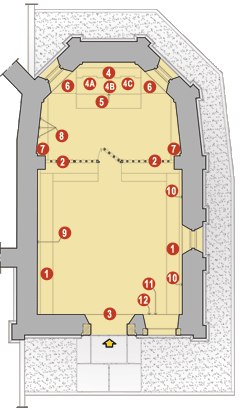
CAPTIONS
(1) Walnut dossals (sec. XVII)(2) Wooden rail fence with kneeling-stools
(3) Door with Buzzatti’s family coat-of-arms
(4) The wooden altar
(5) The wooden frame of the frontal
(6) Corner cabinets (17th century)
(7) Wooden benches
(8) The altar cards (fine sec. XVII)
(9) The frame in gilt wood (fine sec. XVII)
(10) Paintings on canvas
(11) Engraved stone bearing an inscription in Gothic characters
(12) Memorial tablet witnessing the 1946 restructuring work
Note for Internet users: red numbers, ex. (5), referring to this plan are reported in the text of the website.
(1) Walnut dossals (Sec. XVII)
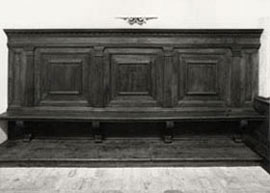 Two walnut dossals (17th century), set on platforms, are placed against the sidewalls of the little room. The benches lean on carving legs corresponding to the Doric capital pilasters on the wall and containing some panels with carving frames.
Two walnut dossals (17th century), set on platforms, are placed against the sidewalls of the little room. The benches lean on carving legs corresponding to the Doric capital pilasters on the wall and containing some panels with carving frames.
Between the hall and the apse is a walnut iconostasis, interrupted by a door in the centre, having a kneeling-stool as a platform. On the door, the coat of arms of the Buzzatti family has been carved in the centre of the lower panel. In the upper part, the partition wall is characterized by twenty small columns and by a trabeation fillet. A moulded cymatium, representing the heraldic coat of arms, is to be found in the centre, with two angels aside. On the side facing the altar, based on the same structure, there are two cabinets with deal doors.
A small walnut built-in cupboard (end of the 19th century) and two corner cabinets set on the sides of the altar (17th century) fit out the small apse. The cabinets, with their simple but precise workmanship, are embellished by an elegant carving work on the doors, on the frieze, on the uprights and on the two raised backs. Along the shorter sides are two walnut benches whose shape follows the line of the wall. They are simply formed by the sitting leaning on strong carving legs and showing a carving frieze under it.
(2) Wooden rail fence with kneeling-stools
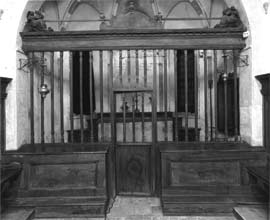
(3) Door with Buzzatti’s family coat-of-arms
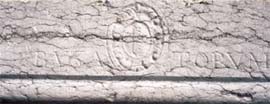
(4) The wooden altar
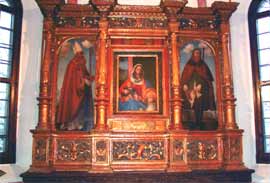 Inside the oratory, visitors are immediately struck both by the magnificent wooden altar and by its paintings. Planned by Vittore Scienza (1506), the elaborate architectural work of art houses three paintings by Giovanni Agostino da Lodi, called Pseudoboccaccino. On a platform, four columns rise on projecting dies, thus marking the space among the Virgin Mary and the Holy Child in the centre, and the Saints Rocco and Nicolò asides. Classical painted decorations of great value create gold carvings on dull blue tempera-painted backgrounds, representing, in particular, a horse and two dolphins; grotesque figures with a decorative foliage motif and grapes; Roman hermae; vases of fruits and flowers; and, finally, cherubs with pearls and ribbons.
Inside the oratory, visitors are immediately struck both by the magnificent wooden altar and by its paintings. Planned by Vittore Scienza (1506), the elaborate architectural work of art houses three paintings by Giovanni Agostino da Lodi, called Pseudoboccaccino. On a platform, four columns rise on projecting dies, thus marking the space among the Virgin Mary and the Holy Child in the centre, and the Saints Rocco and Nicolò asides. Classical painted decorations of great value create gold carvings on dull blue tempera-painted backgrounds, representing, in particular, a horse and two dolphins; grotesque figures with a decorative foliage motif and grapes; Roman hermae; vases of fruits and flowers; and, finally, cherubs with pearls and ribbons.(4A) THE PAINTINGS - SAN NICOLO'
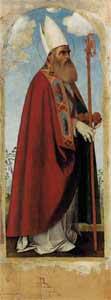 San Nicola (or San Nicolò)
San Nicola (or San Nicolò)(4B) THE PAINTINGS - MADONNA COL BIMBO
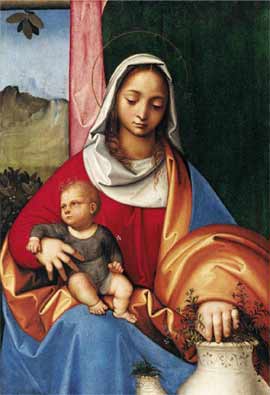 Madonna col Bimbo (by Giovanni Agostino da Lodi - "Pseudo Boccaccino")
Madonna col Bimbo (by Giovanni Agostino da Lodi - "Pseudo Boccaccino")(4C) THE PAINTINGS - SAN ROCCO
 San Rocco
San Rocco(5) The wooden frame of the frontal
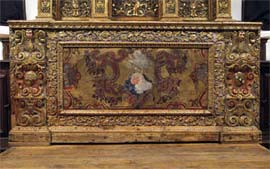 The polychrome frame of the frontal in gilt wood can be attributed to the local Auregne’s school (17th century). The decoration shows a very refined carving similar to the one set on the main altar in S. Gregorio nelle Alpi.
The polychrome frame of the frontal in gilt wood can be attributed to the local Auregne’s school (17th century). The decoration shows a very refined carving similar to the one set on the main altar in S. Gregorio nelle Alpi. The whole structure is divided into three parts by two pilasters decorated with acanthus leaves and cherubs’ heads, with two heraldic coats of arms standing out. In the central part, a frame with acanthus leaves marks the seat of the leather frontal. The space between the central frame and the pilasters is decorated with acanthus leaves and racemes motives. A refined frame representing small roses runs along the top.
(6) Corner cabinets (17th century)

(7) Wooden benches
(8) The altar cards
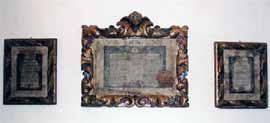 The group of the three altar cards refers to the same period and school of the previously- described frame. The three pieces - in stone pine wood and consisting of a central, more varied and bigger frame and of two simple ones at the sides - make a whole thing. They represent a painted carving with partially gilt acanthus leaves motif on a green lacquered silver leaf.
The group of the three altar cards refers to the same period and school of the previously- described frame. The three pieces - in stone pine wood and consisting of a central, more varied and bigger frame and of two simple ones at the sides - make a whole thing. They represent a painted carving with partially gilt acanthus leaves motif on a green lacquered silver leaf.(9) The frame in gilt wood
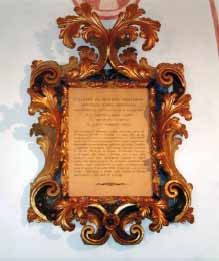 It is a refined polychrome Baroque frame in gilt and lacquered stone pine wood. The ornamental carving of good craftsmanship and accurate design represents acanthus leaves, volutes and ribbons. Probably dating back to the end of the 17th century and the beginning of the 18th,, it was made by a carving school whose style was similar to the one of the Brustolon in Belluno.
It is a refined polychrome Baroque frame in gilt and lacquered stone pine wood. The ornamental carving of good craftsmanship and accurate design represents acanthus leaves, volutes and ribbons. Probably dating back to the end of the 17th century and the beginning of the 18th,, it was made by a carving school whose style was similar to the one of the Brustolon in Belluno.(10) Paintings on canvas
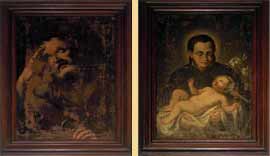 “San Pietro” by an unknown painter.
“San Pietro” by an unknown painter.(Dim. 50,5 x 73,0) Oil painting on canvas.
Saint Peter, holding a key in his hand, is depicted in tears. The canvas is made of thin closely-woven yarn. The paint compound, probably made of plaster and size, is brown-red coloured.
“Saint with lily and the Holy Child” by an unknown painter.
(Dim: 50,5 x 73,0) Oil painting on canvas.
The Saint is probably either San Luigi Gonzaga or San Gaetano da Thiene. The canvas is worked like the previous one, but made of middle-woven yarn. The ochre-coloured paint compound, made of plaster and size, is spread in thin layers.
The original artistic quality of the two paintings was surely good. Both their precise details and composition imply the presence of a good scholarly level. The Saint with the Holy Child was probably painted later on.
(11) Engraved stone bearing an inscription in Gothic characters
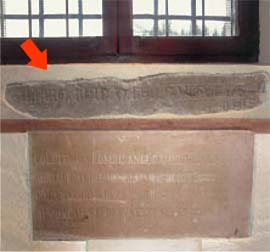
(12) Memorial tablet witnessing the 1946 restructuring work

This website and its publications have been realized by a:
 |
 |
 |
| PROGETTO COFINANZIATO DALL'UNIONE EUROPEA FONDO - F.E.A.O.G. Sezione orientamento |
||
 |
PROGRAMMA LEADER PLUS Gruppo Azione Locale "Prealpi Dolomiti" |
 |
 Printable version of the plan
Printable version of the plan